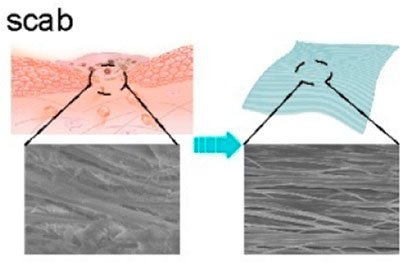| May 29, 2013 |
Human scabs serve as inspiration for nanofiber bandage to speed healing
|
|
(Nanowerk News) Human scabs have become the model for development of an advanced wound dressing material that shows promise for speeding the healing process, scientists are reporting. Their study appears in the journal ACS Applied Materials & Interfaces ("Scab-Inspired Cytophilic Membrane of Anisotropic Nanofibers for Rapid Wound Healing").
|
 |
| Inspired by the anisotropic protein nanofibers in scab, a polyurethane (PU) nanofibrous membrane with an aligned structure was fabricated. The membrane showed good affinity for wound-healing-related cells and could guide cell migration in the direction of PU nanofibers. This scab-inspired cytophilic membrane is promising in applications as functional interfacial biomaterials for rapid wound healing, bone repair, and construction of neural networks. (© ACS)
|
|
Shutao Wang and colleagues explain that scabs are a perfect natural dressing material for wounds. In addition to preventing further bleeding, scabs protect against infection and recruit the new cells needed for healing. Existing bandages and other dressings for wounds generally are intended to prevent bleeding and infections. Wang’s team set out to develop a new generation of wound dressings that reduce the risk of infections while speeding the healing process.
|
|
They describe how research on the surface structure of natural scabs served as inspiration for developing a “cytophilic” wound dressing material. It attracts new cells needed for healing. The material mimics the underside of scabs, where tiny fibers are arranged in the same direction like velvet or a cat’s fur. Wang’s team spun fibers of polyurethane — the common durable and flexible plastic — into the same pattern. In laboratory experiments, the human cells involved in healing quickly attached to the membrane and lined up like those in actual scabs.
|
|
The scientists conclude that this membrane “is of great potential in fabricating dressing materials for rapid wound healing, as well as other biomaterials, such as membrane for capturing circulating tumor cells, bone growth and constructing neural networks.”
|

